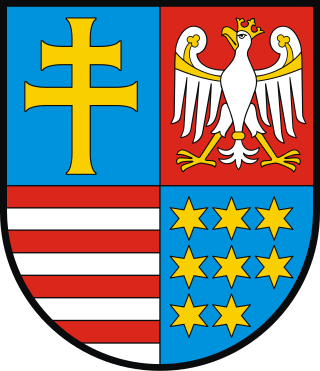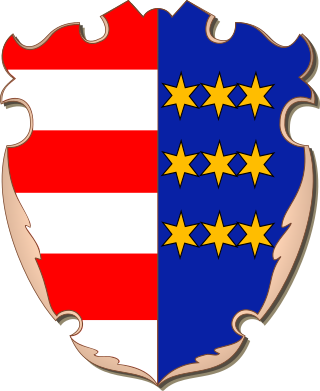
The civil flag of the Lublin Voivodeship, Poland is a tricolour rectangle, with three horizontal stripes: white (silver), red, and yellow (golden), with the coat of arms of the voivodeship, in form of the white (silver) malejumping cervus, with a yellow (golden) crown on its neck, placed on the red escutcheon, placed in the centre of the flag. The cervus is facing left. The top and bottom stripes are twice the size of the middle stripe.

The civil flag that serves as the symbol of the state of Mecklenburg-Vorpommern, Germany, consists of five horizontal stripes, that are from the top to bottom: blue (ultramarine), white, yellow, white, and red (vermilion). It was designed by Norbert Buske and adopted on 29 January 1991. It is a combination of the historical flags of the Mecklenburg and Western Pomerania.

The coat of arms that serves as the official symbol of the Masovian Voivodeship, Poland, consists of a red escutcheon, that features a white (silver) eagle, with raised wings, and its head turned left. Its current version had been designed by Andrzej Heidrich, and adopted in 2006.

The coat of arms of the Lesser Poland Voivodeship, Poland features a white (silver) eagle with a yellow (golden) crown on his head that is turned left, a beak, legs, and a stripes on its wings, with the charge placed on the red background. It was designed by Wojciech Drelicharz, Zenon Piech, and Barbara Widłak, and adopted in 1999.

The coat of arms of the West Pomeranian Voivodeship, Poland depicts a red griffin with yellow (golden) beak and claws on the white (silver) background. The coat of arms was created by Jerzy Bąk and adopted in 2000.

The coat of arms that serves as the symbol of the city of Szczecin in West Pomeranian Voivodeship, Poland depicts the head of a red griffin with a yellow (golden) beak wearing a yellow (golden) crown, placed on the blue background.

The coat of arms of Kashubia (Kashubian: pòznaka Kaszëb) is the coat of arms representing Kashubians. It usually is a black griffin with a crown on a yellow background, which used to symbolise the House of Griffin.

The flag is the symbol of the city of Szczecin in West Pomeranian Voivodeship, Poland.

The Bernstein Land, also known as the Pełczyce Land, is a historical region in Western Pomerania in Central Europe, centered around the town of Pełczyce, Poland.

The flag of the West Pomeranian Voivodeship, Poland is a triband rectangle, divided vertically in 3 stripes of white, red, and white colour, and with the coat of arms of the voivodeship in the middle. It was adopted in 2000.

The flag is the symbol of the Subcarpathian Voivodeship, Poland.

The coat of arms of Kamień County, West Pomeranian Voivodeship located in Poland, is divided horizontally into blue and white stripes, with 2 golden (yellow) crosiers and 2 red roses within blue stripe, and red Griffin with yellow claws and beak, within the white stripe. The flag of the county is a rectangle divided horizontally into white and blue stripes, with the coat of arms in the middle.

The coat of arms of the Łódź Voivodeship, Poland is an Iberian-style escutcheon with square top and rounded base. It is divided horizontally into three stripes (pales), that area from left to right: yellow (golden), red, and yellow (red), with the middle stripe being twice as big as the other stripes. It also include three charges placed in its center, with two placed next to each over, on the top of the third one. The top two charges are Kuyavian Hybrids, divided into half, into a lion and an eagle, while the bottom one is an eagle. It was designed by Marek Adamczewski, and officially adopted on 25 June 2002.

The coat of arms of the Kuyavian-Pomeranian Voivodeship, Poland, consists of a white (silver) escutcheon, with a half of an eagle facing left, joined with a half of a lion facing right, both animals together wearing a yellow (golden) crown on their joined heads. It had been adopted in 2000.

The flag that serves as the symbol of the historical and geographical region of the Western Pomerania is divided horizontally into two stripes: light blue on the top and white on the bottom. It originated as the flag of the Province of Pomerania, Prussia, used from 1882 to 1935. Since 1996, it is officially recognized as the symbol of the historical region of Western Pomerania within Mecklenburg–Western Pomerania, Germany.

The flag that serve as the symbols of the Koszalin County, West Pomeranian Voivodeship, in western-norther Poland was established in 2001, and the coat of arsm, in 2002.

The coat of arms and flag that serve as the symbols of the Police County, in West Pomeranian Voivodeship, Poland were established on 28 June 2000. They were designed by Radosław Gaziński.

The coat of arms that serves as the symbol of the Świętokrzyskie Voivodeship, Poland, consists of the Iberian style escutcheon (shield), with square top and rounded base, that is divided in the 2 by 2 chessboard pattern. The top left field features a yellow patriarchal cross. The top right field features a white eagle with yellow crown, beak, legs, stripes on its wings, and a ring on its tail. The bottom left field features eight yellow six-pointed starts, placed in three rows, each with three stars, with the exception of the bottom row, that only had 2 stars, placed to the left.

The historical coat of arms, that served as the symbol of the Sandomierz Land, and the Sandomierz Voivodeship of the Kingdom of Poland, from 14th to 18th centuries, was divided into two fields, with the left field consisting of six stripies, that were alternatining either between red and white, or red and yellow colours, and with the right field consisting of several yellow six-armed stars, which number altered between seven and nine.

The coat of arms that serves as the symbol of the Podlaskie Voivodeship, Poland is divided into two horizontal red fields. The top field depicts a white eagle, and a bottom field, a knight in a white (silver) armor, sitting on a white (silver) horse with a blue saddle and shabrack, and yellow (golden) harness, standing on its back hoofs. The knight has a blue shield with a yellow (golden) cross of Lorraine on it, put on his left arm, and hold a sword in his right hand. The current design of the coat of arms was designed by Tadeusz Gajl, and adopted in 2001.























